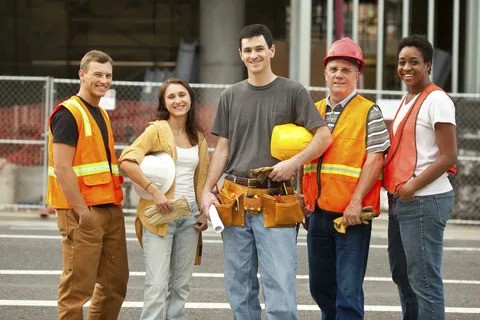USA Construction Jobs
The construction industry is the backbone of America’s infrastructure, economy, and innovation. From towering skyscrapers in New York City to renewable energy plants in Texas, construction jobs fuel growth, create communities, and offer pathways to stable, lucrative careers. With over 8 million workers and a projected $2.1 trillion in spending by 2025, the sector is booming—yet it faces a critical labor shortage. This guide dives into the opportunities, requirements, challenges, and trends shaping construction jobs in the USA, equipping you with the knowledge to build a successful career in this dynamic field.
The State of the Construction Industry in the USA
The U.S. construction sector contributes $1.4 trillion annually to the economy, employing 7.4 million people as of 2023 (U.S. Bureau of Labor Statistics). Key drivers of growth include:
- Infrastructure Investment and Jobs Act (2021): A $1.2 trillion federal package funding roads, bridges, broadband, and green energy projects.
- Housing Demand: A shortage of 6.5 million homes fuels residential construction, especially in Sun Belt states like Florida and Arizona.
- Renewable Energy Expansion: Solar and wind projects require specialized labor, from electricians to crane operators.
Despite this momentum, the industry faces a shortfall of 546,000 workers in 2023 (Associated Builders and Contractors). Retiring Baby Boomers and a lack of young entrants exacerbate the gap, creating prime opportunities for job seekers.
Types of Construction Jobs in the USA
Construction roles vary widely, from hands-on trades to high-level management. Below are key categories:
1. Skilled Trades
These roles require specialized training and certifications:
- Electricians:
- Responsibilities: Install wiring, troubleshoot systems, and ensure compliance with safety codes.
- Salary: 60,000–100,000 annually (median $63,310).
- Requirements: State license, apprenticeship (4–5 years), and OSHA 10 certification.
- Plumbers and Pipefitters:
- Focus: Install and repair water, gas, and HVAC systems.
- Salary: 56,000–95,000 (median $65,190).
- Certifications: Journeyman or master plumber license.
- Carpenters:
- Roles: Framing, finish carpentry, or cabinetry.
- Salary: 40,000–75,000 (median $56,350).
- Training: Apprenticeship or vocational school.
2. Heavy Equipment Operators
- Machines Operated: Excavators, bulldozers, cranes.
- Salary: 45,000–85,000 (median $63,470).
- Certifications: NCCCO crane certification or state-specific licenses.
3. Construction Managers
- Duties: Oversee projects, budgets, timelines, and subcontractors.
- Salary: 70,000–150,000+ (median $101,480).
- Education: Bachelor’s degree in construction management or engineering.
4. Laborers
- Tasks: Site preparation, material handling, and assisting tradespeople.
- Salary: 30,000–50,000 (median $40,750).
- Entry Point: No formal education required; on-the-job training.
5. Specialized Roles
- Ironworkers: Reinforce structures with steel ($58,550 median).
- Solar Panel Installers: Fast-growing field due to green energy demand ($48,190 median).
- Welders: Join metals for pipelines, buildings, or machinery ($47,540 median).
Requirements to Enter the Construction Workforce
Education and Training
- High School Diploma: Required for most apprenticeships.
- Trade Schools: Programs in welding, HVAC, or electrical work (6 months–2 years).
- Apprenticeships: Paid, hands-on training through unions (e.g., International Brotherhood of Electrical Workers) or contractor associations.
Certifications
- OSHA 10/30: Mandatory safety training for most sites.
- CPR/First Aid: Often required for supervisory roles.
- LEED Accreditation: For professionals in sustainable building.
Licensing
- State Licenses: Electricians, plumbers, and contractors must pass exams.
- Commercial Driver’s License (CDL): For operating heavy machinery.
Soft Skills
- Physical stamina, teamwork, problem-solving, and attention to detail.
How to Find Construction Jobs
- Job Boards:
- Indeed, LinkedIn, and ConstructionJobs.com.
- Niche sites: iHireConstruction, CareersInConstruction.
- Unions and Associations:
- North America’s Building Trades Unions (NABTU): Connects workers with apprenticeships.
- Associated General Contractors (AGC): Job listings and training resources.
- Recruitment Agencies:
- Firms like Tradesmen International specialize in temporary or permanent placements.
- Networking:
- Attend industry events like CONEXPO-CON/AGG or local trade fairs.
Visa Pathways for International Workers
The U.S. construction industry relies on foreign labor to fill gaps. Key options include:
- H-2B Visa: For temporary non-agricultural workers (cap: 66,000 annually).
- EB-3 Visa: Green card for skilled workers with permanent job offers.
- TN Visa: For Canadian/Mexican professionals under NAFTA (e.g., engineers).
Salary and Benefits
- Union Advantages: Higher wages (20–30% above non-union), health insurance, and pensions.
- Overtime Pay: Time-and-a-half for over 40 hours/week.
- Perks: Company trucks, tool allowances, and relocation bonuses in remote areas.
Challenges in Construction Careers
- Physical Risks: Injuries from falls, equipment, or exposure to hazardous materials.
- Weather Dependency: Outdoor work halts during extreme conditions.
- Economic Sensitivity: Layoffs may occur during recessions or project delays.
Safety Tip: Always wear PPE (hard hats, gloves, steel-toe boots) and follow OSHA guidelines.
Future Trends Shaping the Industry
- Technology Integration:
- Drones and BIM (Building Information Modeling): Enhance site surveys and project planning.
- 3D Printing: Constructing affordable housing and complex structures.
- Green Construction:
- Demand for LEED-certified buildings and net-zero energy projects.
- Roles in solar installation, insulation, and smart home systems.
- Modular and Prefab Construction:
- Off-site building reduces costs and timelines, requiring factory-based workers.
- Infrastructure Renewal:
- Bridges, airports, and railways under the 2021 federal bill need millions of workers.
Tips for Career Advancement
- Specialize: Earn certifications in high-demand areas (e.g., NCCER Core Curriculum).
- Go Digital: Learn software like AutoCAD or Procore for project management roles.
- Start a Business: Experienced tradespeople can launch contracting firms.
USA Construction Jobs
Construction jobs in the USA offer more than just a paycheck—they provide the chance to shape skylines, power communities, and secure a future-proof career. With competitive salaries, union protections, and endless opportunities for growth, the industry welcomes everyone from entry-level laborers to seasoned engineers. As America rebuilds its infrastructure and embraces sustainable innovation, construction professionals will remain in high demand.
Whether you’re swinging a hammer, drafting blueprints, or managing a megaproject, your work lays the foundation for tomorrow.



